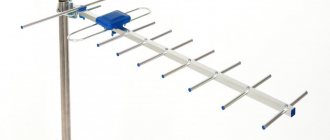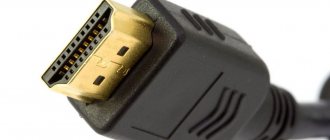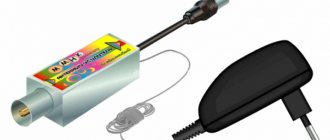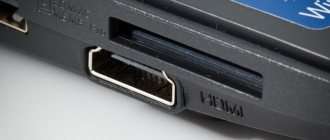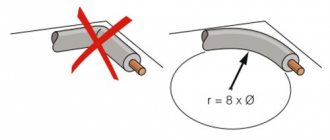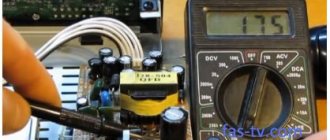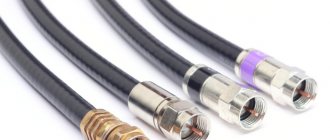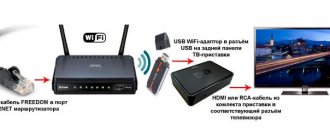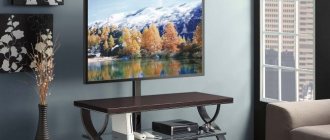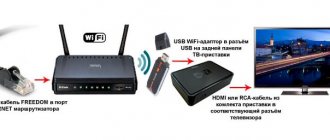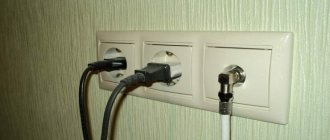Television equipment is connected using various connectors. To combine devices of different years of manufacture and brands, connectors of various shapes and colors are used.
A product designed to connect a cable to television equipment is called an antenna connector, and it is used to connect the antenna to the TV.
Many television and Internet providers use coaxial cable in their networks, so connectors for coaxial cable are used to connect equipment. It can transmit high frequency signals and is used in various fields of communication systems.
Selecting a TV cable
Even an excellent TV and correctly placed F-plugs on the ends of the cable will not be able to provide high quality images on the screen when using a low-quality television cable. And the question arises, which antenna cable is better for connecting a TV and what criteria should you use to choose it?
TV cable device
Let's look at how a modern television coaxial cable works using the example of a CAT-703 cable.
Along the center of the entire length of the coaxial cable runs a copper or steel wire core covered with a copper layer. This core is covered with a layer of insulation made of dielectric material. The insulation is covered with a shielding copper or aluminum foil braid, which acts as a second conductor. To protect against mechanical and climatic influences, the cable is covered with a sealed protective sheath.
Inexpensive cables use only aluminum braid, budget cables use copper, and expensive cables use aluminum and copper at the same time, as shown in the photo.
How does current flow through an antenna cable?
To consciously choose a good antenna cable, you need to imagine how high-frequency current flows. Current in an electrical network flows across the entire cross-section of conductors.
The high-frequency current of a television signal flows according to a different law. Everyone knows how laundry is spun in the centrifuge of a washing machine: the higher the speed, the stronger the centrifugal force acts on the water, and it is better removed from the laundry, the laundry becomes drier. Many people experienced the effects of centrifugal force on their own bodies in childhood while riding on carousels.
The high-frequency current of the television signal flows in the antenna cable in a similar way. The higher the frequency, the closer to the surface of the conductor it flows. The skin effect appears. If we take, for example, a copper wire with a diameter of 10 mm and a copper tube of the same diameter with a wall thickness of 1 mm, then a current with a frequency of 1000 MHz will flow through them with the same losses!
Therefore, in antenna cables used for military and space equipment, to reduce signal loss (attenuation), the central core and cable braid are often coated with a thin layer of silver and even gold. This is a very expensive pleasure, and such cables are not used in everyday life.
Due to the small magnitude of the television signal in the antenna cable and its high frequency, it is not possible to determine its presence in the cable, much less carry out measurements at home without specialized expensive instruments. Only connecting the antenna cable to the TV will determine the presence and quality of the television signal.
TV cable marking
The most widely used antenna cables on the market are coaxial antenna cables from different manufacturers with a characteristic impedance of 75 Ohms, brands RG 6U, SAT 50, SAT 703B and DG 113, which can be successfully used for receiving analog and digital television signals up to transmitting them from a satellite antenna with a frequency of up to 2. 15 GHz. The brands are listed in order of increasing quality of the antenna cable - reducing signal loss (attenuation) during transmission. The marking (designation) must be applied to the antenna cable sheath along its entire length every meter with a digital meter mark.
This antenna cable marking indicates the following:
- CABLETECH – manufacturing company CABLETECH (China).
- RG 6U/48 – cable brand.
- HIGH QUALITY COAXIAL CABLE – high quality coaxial cable.
- 75 OHM – characteristic impedance 75 Ohm.
- 055M – meter mark, with each meter the mark changes by 1.
How to choose a TV antenna cable
The antenna cable sheath must be marked as shown above. The antenna cable must have a characteristic impedance of 75 Ohms (all televisions and switching devices are designed for this impedance - amplifiers, splitters, set-top boxes for receiving DVB-T2 digital channels). The outer diameter of the antenna cable sheath must be at least 6 mm. Central core and shielding braid made of electrical copper. Antenna cables of the SAT 703B and DG 113 brands meet these requirements. The RG 6U cable has a central steel core, galvanically coated with copper, an aluminum foil screen and copper alloy braiding, this is a budget option.
It is impossible to describe all the television cables on the market, but the information presented is quite enough for you to make the right choice yourself.
Coaxial cable connector
The simplest electrical circuit requires a variety of connectors for switching. The TV antenna also requires an appropriate coupling element when connecting.
Coaxial wire is applicable in signal transmission without interference. To contact the TV you need a connector. Telecommunication networks mainly use F-connectors. For a coaxial cable, in case of extension, due to its damage, you will need an F-connector (barrel), which is an F female-F female connector that connects the coax.
To quickly connect the antenna to a receiver or TV, use a TV socket, as well as a plug for the antenna cable.
How to make a TV crab from scrap material
You may have wondered and wondered what a metal box of candy is doing on a page about making your own TV crab.
Yes, this is indeed a box of lollipops, but they are no longer there, since a home-made television crab is made from it, its technical parameters are not inferior to any other industrially produced ones.
If you open the lid and look into the box, everything will immediately become clear. This is a homemade television crab, made according to the above electrical circuit diagram, but instead of connectors, the wire connections are made by soldering.
This design of the crab is completely justified; the television crab is a stationary device, it is installed once and in the future there is no need to change its installation location. And most importantly, such a TV crab can be made from any metal shoebox, sweets, or coffee. The size does not matter, the main thing is that the antenna cable mounting brackets and several radio elements fit.
To make a television crab, you need to make holes in the box at the bottom level for the television cable and in the bottom of the box for mounting brackets. If the walls of the box are thin, then it is better not to drill holes, but to push them through. First pierce it with an awl, then insert the tip of a small screwdriver into the resulting hole and press down while rotating. The hole will get larger. By changing the size of the tool, bring the diameter of the hole to the outer diameter of the television cable. The clamping strips can be made from any metal. The good thing about a pressed hole is that there are no sharp edges that can cut through the cable.
After preparing the box and clamping strips, you need to cut the television cable
It is very important not to cut the central core when removing the insulation. There is no need to remove the cable shielding, but wrap it in place with a strap
Now you need to insert the prepared ends of the television cable into the holes of the box and secure them with clamping strips. Bend the stripped ends of the central core of the cable slightly upward.
All that remains is to mount the transformer and resistor, close the lid and the TV crab will be ready for use. If the box is of small depth, then you need to make sure that the exposed parts of the parts and the central core of the cable do not come into contact with the cover.
If it is not possible to get a ferrite ring to make a transformer for a television crab, then instead of it a splitter can be made using resistors according to the electrical circuit diagram below.
All resistors of the splitter have the same resistance, which, depending on the number of televisions connected to the antenna wire, is calculated using the given formula.
For example, to connect three TVs to a TV crab, the resistance value R will be equal to 75 Ohms × (3−1)/(3+1)=37.5 Ohms. From the standard series, the resistor with the closest nominal value is 36 Ohm, and that’s what you should take.
Below is an online calculator with which you can calculate the value of resistors for a crab, depending on the number of planned televisions or other television signal receivers for connection.
| Online calculator for calculating the value of crab resistors |
| Enter TV quantity: |
The resistor value for making crab is taken from the standard range closest to the calculated one.
The most reliable type of connection of radio components is, of course, soldering. But if it is not possible to perform the connection work in a television crab by soldering, then you can get by by twisting the leads.
For reliable contact, it is enough to tightly wrap the resistor terminal with three to five turns around the central core of the television cable. The contact will not be as reliable as with soldering, but it will be quite sufficient for stable operation of the TV crab.
You can also use a plastic box as a body for a homemade crab if you cover its body and lid from the inside with staniol (aluminum) foil. A prerequisite for this is to ensure electrical contact between the foil of the housing and the cover and with the shielding braids of the television cables.
For reliable contact of the braids, before clamping them with clamping strips, you need to wind several turns of a piece of any copper wire onto each one.
How to install a plug on a TV cable
Before connecting the antenna plug to the cable, you need to properly cut the wire.
- Remove 10 mm of the main shell.
- Bend the braid with a layer of foil (if any) back.
- Remove the inner layer, but leaving about 2 mm. This residue will fit into the connector hole when insertion is done.
Afterwards, start screwing on the plug. If screwing by hand is difficult, use pliers.
But it is not recommended to clamp the part tightly with the tool. Modern metal parts are fragile and can crack under excessive force. Then you will have to buy a new connector.
Step-by-step connection diagram
You need to screw it in all the way. The shielding layer must be completely or almost completely hidden under the body of the part. The vein will protrude a few millimeters from the opposite end. And inside you will see how the insulating PVC layer of the cable will fit into the connector.
The core of the wire should not stick out much. Otherwise, the adapter will not screw in completely. Therefore, if the length is too long, shorten it with pliers or carefully trim it with scissors.
Once the connector is seated, screw the F adapter into the threads. Afterwards, you can connect the plug to the TV.
The instructions given are useful in almost all situations when working with an antenna cable. For example, when connecting 2-3 TVs to one digital television antenna. There, the circuit uses a splitter (divider), which must be connected via the F-connector. The same applies to extending or repairing a line. All connections are made only through connectors with the necessary adapters.
How to choose a TV tuner
When planning to order a TV tuner for a monitor, computer, laptop or car, read the selection criteria. A competent and thorough approach will help you choose a truly optimal video tuner that will receive TV channels from a car antenna or satellite and cable TV
To do this, pay attention to some useful tips:
Decide between an analog and digital device. The first option is perfect if you are going to make the usual terrestrial television, which you receive on a collective or indoor rooftop, or if you have cable TV at home. This type of customizer is the most difficult to implement, because... it should provide good reception quality in different conditions and protection from interference. Digital may be the preferred option because... Digital television has become widespread today. You can often find hybrid models that can support multiple signal types. Choose between internal and external TV tuner. The first one takes up minimal space, because installed inside the PC, but to do this you need to open the computer case
An external device connected via USB is more convenient in this regard. Please note additional features. It will be good if the selected model can capture video, receive signals from FM radio stations, etc.
For digital television
If you are interested in digital TV, then pay attention to DVB-T tuners. Compared to analogue broadcasting, digital broadcasting can provide high picture quality regardless of various types of interference.
A digital stream often includes several audio tracks, including multi-channel ones. In addition to DVB-T, digital video tuners include DVB-S/S2 and DVB-C - the former are satellite, and the latter are cable. You can immediately purchase a kind of mega-hybrid TV tuner that combines analog and two digital types of television broadcasting.
For analogue television
The device chosen for analogue TV must be able to provide an acceptable level of quality in different conditions and have developed signal processing mechanisms. True, not all models of analog tuners can meet these requirements. Some devices have extremely limited functionality and provide the user with unsatisfactory quality images. Of particular importance is the functionality and ease of use of the software. The ideal choice would be a hybrid version of the TV tuner, which can also be used for digital TV.
For auto
Active antennas installed inside the car on the windshield have become very popular. Such antennas are compact in size. To increase the functionality of this type of device, choose a suitable TV tuner. Digital DVB-T2 models are also in demand, used to receive different communication channels. Thanks to them, you can watch your favorite programs at a high-quality level. Among the well-known car digital receivers are INCAR DTV-16, BGT-TV-Box, MyDean DTV-1519, etc. However, their cost exceeds 11-12 thousand rubles.
Connecting to the power supply
Organizing such a connection is required when an active antenna is used together with a TV (but without a set-top box) to receive channels. The antenna has a built-in amplifier that requires power. Voltage is supplied via an external power supply. The device connects to the antenna at the end of the wire, which is inserted into the television receiver.
A wire with a separator at the end comes off from the block. It is necessary to unscrew the separator, cut the wire and clamp it in the fastenings of the separator board with bolts.
The stripping dimensions can be determined visually. The main thing is to ensure that there is no contact between the shielding and the conductor.
Digital cables
There are several digital cables, but most are computer standards. For television, a separate universal connector has been developed, which we will now analyze.
HDMI cable
An HDMI cable for transmitting a digital signal
HDMI (High Definition Multimedia Interface) can easily be called the pinnacle of the evolution of television cables. It transmits high-definition digital video signals as well as multi-channel audio. Modern versions of this cable are able to protect transmitted information from copying.
Essentially, this is a computer DVI standard supplemented with sound, so when connecting a PC to a TV, you can use both connectors, but you first need to get an adapter.
When switching to such a connection, look for the corresponding item in the TV menu.
Selected HDMI 1 input
This connector was able to replace all previous analogues, thanks to which modern multimedia devices have become much smaller in size, since there is no longer a need to place outdated connectors and boards for them in the device body. However, it would not be amiss to note that a device that has more than one output will continue to function even after one of them fails, which cannot be said about mono-connected options.
Here are the main parameters of HDMI cables:
- HDMI has high throughput from 4.9 Gb/s for version 1.0, to 48 for version 2.1. New models allow you to watch video in very high resolution (8K) and play 3D format on appropriate TVs.
- The length of the standardized cable does not exceed 10 meters, so the quality will not be lost during transmission. There are also non-standard options, up to 35 meters, but for them it is better to additionally install signal amplifiers (repeaters).
- Support for CEC and AV.link control protocols.
- They have a shielding braid and ferrite rings (not on all models) along the edges of the cable to cut off interference.
Matching connectors for HDMI cables on the back of the TV.
You can find out more about the technical characteristics of the cable version on the manufacturer’s website or, for example, on Wikipedia. Full tables with all the necessary data for each version are available there.
Among the disadvantages, it is worth noting the high price, especially for branded options equipped with all degrees of protection and with connectors coated with precious metals.
We will simply recommend that people who want a better picture purchase this cable, if this has not been done previously, and your system supports such a connection. The image quality will increase several times, provided that a high-definition signal is supplied to the TV.
Today, many channels are moving to HD broadcasting, and it is gradually becoming an accepted standard. We assure you that watching any program about wildlife on the Discovery channel in this quality will be much more interesting and enjoyable.
Also, you can easily connect your computer to your TV without any hassles with wires and watch movies in high quality directly from the Internet.
Now you know exactly what a television cable is, and which one is best to choose from the whole variety. The development of technology does not stand still, and every day new requirements for standards arise. Today, HDMI meets all requests, although who knows, maybe tomorrow they will come up with ultra-high-speed holographic projectors, or something like that, and this standard will also begin to fade into oblivion.
Checking the connection
There are two ways to check the correctness and quality of the connection.
- Use a measuring device to check if there is a short circuit and find out the signal level from the antenna. If there is no short circuit, and the signal is received, it means that the connection is completed correctly, you can tune in television channels.
- Connect the TV to an over-the-air receiver, try setting up digital TV, and additionally check the TV signal level in the manual search menu.
The TV signal level should only be viewed on working channels (multiplexes) in your area. Therefore, you first need to determine which channel number is broadcast from the nearest repeaters. Go to the digital broadcasting coverage map and use the search to find your home. You need to enter the full address of the house, click on the “Find” button and select the house on the map. Next, the parameters of the towers will appear, where the TVC numbers will be written.
The value for each channel is set one by one. Look at the reception level, and then draw conclusions. If the signal is too weak, you should try to adjust the antenna more accurately or completely replace the receiver with a more powerful one. If a passive type of ethereal device is currently working, you need to think about installing an active one.
What it is?
HDMI cables are a special device with which digital audio and video signals are transmitted from one multimedia device to another, while the quality during transmission remains at a high level and is not affected by electromagnetic interference. An HDMI cable looks like a long cord, with connectors at both ends. One of these connectors has a rectangular or trapezoidal flat design.
So, for example, it is possible to connect a video player, receiver, laptop, decoder, video card, camera to the TV. As a result of this connection, you will receive a clear, full-color image and clear analog sound on your TV screen.
Today, HDMI cables are considered the main connecting devices that are used to transmit data in digital format at high speed. Such a wire is capable of transmitting a video signal at a speed of 48 bits, and an audio signal at a speed of 24 bits. When a signal from a multimedia device enters your digital TV, re-encoding occurs inside it, and the video image may appear slightly double, however, by using HDMI cables for the connection, this ghosting effect can be completely avoided.
Connectors for connecting equipment
Antenna connectors installed on televisions are called TV sockets. To start broadcasting channels, you need to connect the plug for the television cable to the socket.
The plug is essentially a sleeve of two components, the so-called male-to-male adapter, which is attached to the cable.
It is important to ensure good contact at the connection point, then the image will be of high quality. The matter seems to be not complicated, but the image and sound will be noisy if done incorrectly, no matter what kind of TV you have: the latest model or an old one.
Exploitation
It is very important to connect the cable to the TV correctly. There are two types of fasteners: crimp plugs and screw plugs
The easiest way to connect is using an angled or straight F plug, and for the wiring itself you can use a very ordinary knife. The work includes several steps.
Cut the outer layer of the cable to a length of approximately 1.5 cm and remove it, after which you need to wrap the screen and foil, remove the insulating layer, release the core and screw it onto the plug. Then you need to cut the protruding part of the main core to the required length.
The crimp ring should be carefully wound around the edge, cut off the insulating surface to a length of about 6 mm and removed. The cleaned part must be freed from all layers down to the copper tube - this must be done as carefully as possible, since if damaged, the signal quality will deteriorate significantly.
Slide the shell along its length until the inner fiber begins to protrude from the center
After this, all that remains is to connect the connector to the end of the wire, clamp it with the prepared crimp ring, ring the equipment and make sure it is working. Next, you need to cut off all the protruding wires, turn on the TV and enjoy watching your favorite TV shows.
To learn how to connect the antenna cable to the plug, see the following video.
How to connect without a plug
To quickly temporarily resume television viewing, you can quickly connect the television connector to the television cable with an ordinary contact.
- First you need to find some kind of tube, cut it and put it on the slot of the socket in the TV device.
- Next, the TV wire is stripped, the core is bent in half to form a loop. This way the core will be in good contact with the inner surface of the central groove of the antenna input.
- The braid needs to be fluffed up and the core inserted into the connector. Then, using a screwdriver or other thin object, the braid is tucked into the free space of the socket.
You can understand the installation principle from the figure below.
To make the contact more or less reliable, you can insert several matches into the input, which will press the shielding layer more firmly to the input contact.
HDMI ARC what is it
What is HDMI ARC. The HDMI in3 (ARC) audio return channel connection is standard starting from version HDMI 1.4; the HDMI cable, in addition to the video signal, also transmits an audio signal back from the TV to the speakers, so you can also output sound from the TV. All HDMI ports since version 1.4 support this feature. But there are cases when the manufacturer of HDMI chips, to reduce the cost of production, makes the audio return channel only in one port. This is common practice. But according to the rules, if the port is HDMI 1.4 or later, all ports must support ARC.
Unlike previous versions, when it was necessary to use external acoustics to output sound. The return channel will allow you to receive, for example, a signal from the air and output sound via HDMI to connected speakers, but in an uncompressed format, only stereo. The 5.1 audio format is transmitted only in a compressed format up to HDMI 2.1.
F-connector
When connecting a television antenna today, they use the F-connector. It is not difficult to install yourself and does not require specific tools. The following materials are used for production:
- nickel plated zinc;
- plated brass;
- copper.
In the case where the TV is hung close to the wall, an angled L-shaped plug is used.
USB port
Universal Serial Bus is the serial transmission of data between electronic devices. A four-wire cable is used to connect peripheral devices to the USB bus, two wires are used to send and receive data, and two wires are used to power the peripheral devices. With built-in USB power cables, you can connect a USB device without its own power source. USB provides 5V 0.5A as standard, but comes at the expense of more 0.5A power consuming devices in TVs and custom ports to output increased 1A power. The picture shows (enlarges) a Samsung SMART TV 3D Full HD LED UE40ES6100 TV, on which the bottom USB connector is labeled HDD 5V 1A.
Two standards are used: USB 2.0, USB 3.0.
USB 3.0 is the third major version of the Universal Serial Bus (USB) standard for connecting to a computer. Among other improvements, USB 3.0 adds a new data transfer mode called "SuperSpeed" (SS), capable of transferring data at speeds of up to 5 Gbps (625 MB/s), more than ten times faster than 480 MB/s. (60 MB/s) compared to the high speed of USB_2.0″. In addition to the different connectors used on USB 3.0 cables, they are also distinguished by the blue color of the ports or the SS initials on the connectors. USB is used in televisions to connect external storage devices and web cameras
Need for an amplifier
The use of an amplifier in a circuit is justified if:
- the television broadcaster is located very far from your home;
- several television receivers are connected to one antenna receiver (the signal is divided, which means it decreases, therefore amplification is required);
- a low-power antenna that receives poorly even if a TV tower is installed close to it.
You can make sure that you need to install an amplifier in the TV settings. Go to the search menu on your TV or receiver. Open the menu called "Manual Search". Look at the “Signal Level/Quality” scale. If the percentage value is below 50%, then it is better to get an amplifier.
The scale is based on the example of a modern LG Smart TV.
The value will only be shown on broadcast frequencies in your region. Therefore, you must first go to the CETV map. Next, find out the TVK numbers and the corresponding frequencies on which TV towers broadcast in your region. Select a channel in the manual search mode section and look at the level.
An amplifier is also necessary if small squares periodically appear on the screen and the image freezes. All this may be accompanied by a complete loss of signal with the following messages: “No signal”, “Weak signal”, “No signal”, “Check the antenna connection”.
There are two ways out of the situation:
- purchasing, installing and configuring a new active antenna;
- connecting a separate amplifier to the active antenna.
TV OUTLETS IN THE HALL
Electrical socket – 1 pc.
TV socket – 1 pc.
Internet socket – 1 pc.
Multimedia socket - 1 pc.
If additional equipment will be connected to the TV, a DVD player, a computer, a game console, an audio receiver, a home theater, etc. The composition of TV sockets and their location will be slightly different.
Most often, the presence of additional equipment also means a place to install it next to the TV, namely various consoles, cabinets, cabinets, etc. Therefore, all additional electrical outlets are made there, and one behind the TV is enough.
We must make a TV socket and an Internet socket (RJ45), according to the same scheme as described above and for the same reasons.
Multimedia socket is a fairly broad concept, not everything is so simple here, I’ll try to explain.
The main task facing us is to connect the TV with other devices, and depending on the specific equipment, completely different interfaces can be used, with different cables, connectors, plugs, etc.
Recently, almost all multimedia devices have an HDMI (High Definition Multimedia Interface) interface in their arsenal. To connect, you use HDMI cables that are already familiar to everyone; with their help, you can connect almost any modern audio and video devices to your TV, and TVs themselves always have several HDMI connectors.
Therefore, it is best to make a multimedia outlet behind the TV with an HDMI interface. In this case, the cable from it must go to the installation site of additional multimedia equipment. Most often, you simply buy a standard HDMI cable of the required length in a store and lay it from the TV to the equipment, or preferably two.
The main disadvantage or weak point when choosing exactly this type and number of sockets for a TV is this multimedia socket. It may happen that your equipment does not have an HDMI connector, or the HDMI cable laid during repairs fails, because it may have to be periodically plugged into various devices, as needed.
To avoid all these problems, it is necessary, instead of a specific multimedia outlet, to make a channel to the location of the equipment at the repair stage. As a channel, you can use, for example, a plumbing sewer pipe with a diameter of 32 mm, a similar corrugated pipe or a 30×20 cable channel.
It is better if such a channel goes directly into the socket box, and then you can install a cable outlet there. This option will allow you to lay any required communications to the TV at any time, while all the wires will be hidden.
What a cable outlet is, what it looks like and what it is used for, you can read HERE.
In the place where all other equipment is installed, usually under the TV, a block is made of several electrical sockets, at least four pieces; in addition, at least one or two Internet sockets are installed, twisted pairs from which are laid to the router and one post is occupied by a cable outlet connected with the same channel behind the TV in the wall.
In order to save some money on specialized sockets and space in the socket block, I advise you not to install separate TV and Internet sockets, but simply run the required cables into one socket box (in this case, the antenna cable is coaxial and the Internet cable is twisted pair ) and install the cable outlet. Make the cables with a margin of length; subsequently, appropriate plugs are put on their ends, which are connected directly to the TV.
Thus, we avoid the need to buy additional connecting wires, get rid of unnecessary connections that negatively affect the quality and reliability of the contact, we have to make fewer socket boxes in the wall and buy fewer specialized, usually expensive, wiring devices such as TV, audio, hdmi. and internet outlets.
In order to correctly choose the height of installation of sockets for a TV on the wall, be sure to read THIS material, in which we calculated the most optimal distance from the floor to the sockets behind the TV, and in addition, we derived a formula by which you can independently calculate this value for each specific case.
